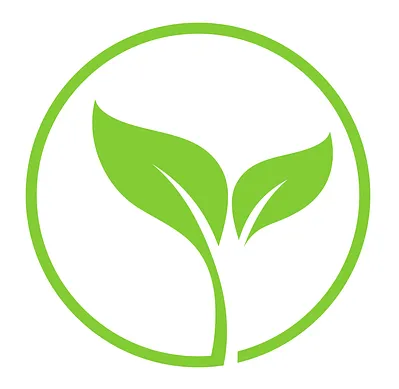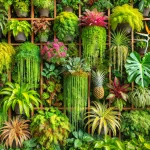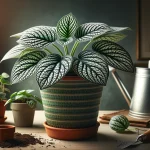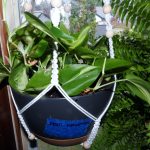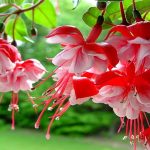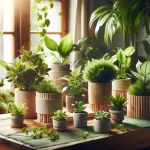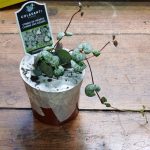This post may contain affiliate links. If you buy something from one of our links we may earn a commission. Thanks
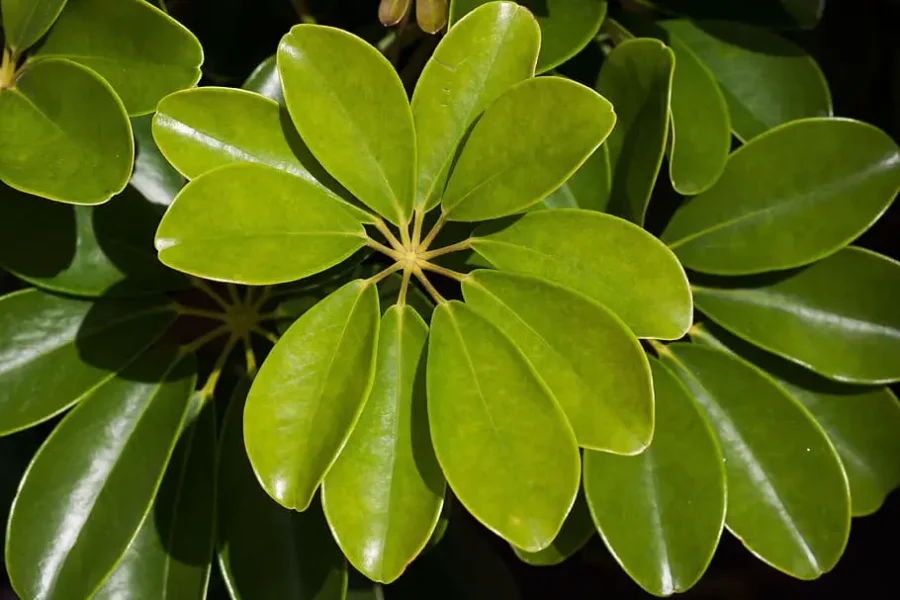
Let’s dive into the wonderful world of Schefflera plant care, also known as Umbrella Plants.
These beauties are popular houseplants, and with the right care, they can thrive indoors.
Here’s a comprehensive guide to help you keep your Schefflera happy and healthy.
Schefflera Plant Care made easy! Learn tips for light, watering, soil, and more to keep your Umbrella Plant thriving indoors with easy Umbrella Plant advice!
Schefflera Plant Care Key Takeaways
- Schefflera Plant Care involves providing bright, indirect light.
- Water when the top inch of soil is dry. Use well-draining soil. Fertilize every 2-3 weeks during the growing season.
- Maintain a temperature of 60-75°F.
- Prune as needed to maintain size and shape.
- Avoid overwatering and watch for pests like spider mites or mealybugs.
Schefflera Plant Care: A Complete Guide to Growing Umbrella Plant
 Schefflera Arboricola ‘Gold Capella’ – 4” from California Tropicals
Schefflera Arboricola ‘Gold Capella’ – 4” from California Tropicals
Introduction to Schefflera Plants
The Schefflera, or Umbrella Plant, is a standout favorite for plant lovers everywhere. Its vibrant, glossy leaves and graceful growth make it a top choice.
Loved for its simplicity, this plant thrives with minimal care, whether inside as a houseplant or outdoors in warmer climates. Let’s explore its unique charm.
Why Schefflera Plants are Popular Houseplants
Schefflera plants are prized for bringing life and greenery to any space.
Their distinctive umbrella-like foliage adds instant appeal, and they adapt easily to most home environments, making them beginner-friendly.
- Visual Appeal: Glossy green leaves create a lush, tropical look.
- Adaptability: Thrives in various lighting conditions.
- Beginner-Friendly: Tolerates occasional care lapses.
Low-maintenance and Easy to Care For
One reason the Schefflera is so popular is its forgiving nature. With basic attention to its needs, this plant rewards you with continuous growth and beauty.
- Minimal Watering Needs: Water only when the topsoil dries out.
- Resilient Growth: Handles occasional neglect without issue.
- Pest Resistance: Less prone to common indoor plant pests.
Versatility: Indoor and Outdoor Beauty
Schefflera plants thrive in homes but can also make a statement outdoors in suitable climates. Their ability to adapt to different environments is a big part of their charm.
- Indoors: Adds vibrant greenery to living rooms, offices, and kitchens.
- Outdoors: In tropical or subtropical areas it grows into a lush shrub or tree.
- Seasonal Transition: Move potted plants outdoors in warm weather.
By understanding why Schefflera plants are so beloved, you’ll be ready to care for and enjoy their beauty in any setting. Want to dive deeper into specific care tips? Let’s explore how to keep your Schefflera thriving!
1. Benefits of Schefflera Plants Indoors
 Thorsen’s Greenhouse Live Arboricola Umbrella Tree Plant, Schefflera Arboricola, Natural Air Purifier, Live Indoor Houseplant, 4-inch Diameter (White – Modern)
Thorsen’s Greenhouse Live Arboricola Umbrella Tree Plant, Schefflera Arboricola, Natural Air Purifier, Live Indoor Houseplant, 4-inch Diameter (White – Modern)
Schefflera plants aren’t just beautiful—they bring multiple benefits to your indoor environment.
These plants can purify the air, regulate humidity, and even improve your mental well-being.
Here’s why adding a Schefflera to your home is a smart and rewarding choice.
Air Purification
Schefflera plants help clean the air in your home, making it healthier to breathe.
- Removes common indoor pollutants like formaldehyde and benzene.
- Contributes to fresher, cleaner air for a healthier environment.
Humidity Improvement
In dry indoor spaces, Schefflera plants naturally increase humidity levels.
- Releases moisture into the air through a process called transpiration.
- Helps prevent dry skin, irritated eyes, and respiratory discomfort.
Stress Relief
Adding greenery to your home can reduce stress and boost your mood.
- Creates a calming and peaceful environment.
- Helps lower anxiety and promote mental relaxation.
2. Plant Size
The Schefflera plant comes in a range of sizes, making it adaptable to both small indoor spaces and larger outdoor gardens.
Whether you want a compact houseplant or a statement piece, understanding its growth potential will help you decide where to place it and how to care for it.
Typical Indoor Height
Schefflera plants are perfect for indoor spaces, growing tall enough to make an impact but staying manageable in size.
- Indoors, they typically grow between 4-6 feet tall.
- The compact size makes them ideal for apartments or homes with limited space.
Outdoor Growth Potential
When grown outside in the right conditions Schefflera plants can reach impressive heights.
- Outdoors, they can grow up to 25 feet tall in tropical or subtropical climates.
- Their larger size makes them suitable as ornamental garden shrubs or small trees.
Tips for Compact Growth
If you want your Schefflera to stay small regular care can help maintain its size and shape.
- Prune back tall stems to control height and encourage bushier growth.
- Keep the plant in a smaller pot to naturally limit its size.
3. Light Requirements
Schefflera plants thrive when provided with the right lighting conditions. They love bright, indirect light, which mimics their natural tropical habitat.
Understanding how much light they need and how to adjust if your space doesn’t have ideal lighting will help keep your Umbrella Plant looking its best.
Preference for Bright, Indirect Light
Bright, indirect light is the perfect match for Schefflera plants, helping them maintain their vibrant, glossy foliage. Direct sun can harm them, so placement is key.
- Place near an east or west-facing window for filtered sunlight.
- Use sheer curtains to diffuse intense light from south-facing windows.
Risks of Direct Sunlight
While light is essential, too much direct sunlight can cause damage to your Schefflera. Recognizing and preventing sunburn is crucial for maintaining healthy leaves.
- Direct sun can scorch leaves, causing brown or crispy edges.
- Move the plant further from the window or provide shade during peak sunlight hours.
Adjusting for Low-Light Conditions
Even if your space doesn’t have abundant natural light, Schefflera plants can adapt. Simple adjustments can ensure they still thrive.
- Supplement with a grow light if your home has limited sunlight.
- Rotate the plant regularly to ensure even light exposure on all sides.
4. Watering Schefflera Plants
Watering your Schefflera properly is key to keeping it healthy and thriving. These plants prefer a moderate approach, not too dry nor too wet.
Observing their needs and adjusting seasonally can avoid common watering mistakes and keep your Umbrella Plant looking its best.
When and How to Water
Schefflera plants enjoy consistent moisture but dislike soggy soil. Allowing the soil to dry slightly between waterings is ideal.
- Water when the top inch of soil feels dry to the touch.
- Use a watering can with a narrow spout to target the soil and avoid wetting the leaves.
Signs of Overwatering and Underwatering
Knowing what to look for can help you quickly identify watering problems and correct them.
- Overwatering: Yellowing leaves or soggy soil are common signs.
- Underwatering: Wilting or curling leaves often indicate a thirsty plant.
Seasonal Watering Adjustments
Adjust your watering schedule based on seasonal changes to meet your plant’s needs.
- Water less frequently in the winter when growth slows.
- Increase watering during the active growing season in spring and summer.
5. Best Soil and Pots for Schefflera
Providing the right soil and pot is crucial for a healthy and thriving Schefflera plant.
These plants prefer well-draining soil that allows their roots to breathe and pots that prevent waterlogging.
Choosing the right combination ensures your plant gets the support it needs to grow beautifully.
Ideal Soil Mix
Schefflera plants need a soil mix that promotes drainage while retaining enough moisture to nourish their roots.
- Use a mix of coco coir, perlite, and compost for a lightweight, nutrient-rich base.
- Avoid heavy garden soil, which can compact and retain too much water.
Pot Selection
The type of pot you use plays a big role in your plant’s overall health. Proper drainage is essential to prevent root rot.
- Choose pots with drainage holes to allow excess water to escape.
- Terra-cotta pots are great for promoting airflow to the roots.
Lightweight and Eco-Friendly Options
If you’re looking for sustainable solutions, there are plenty of eco-friendly pots to consider.
- Look for biodegradable pots made from recycled materials or bamboo.
- Lightweight plastic pots are durable and easy to move while still offering good drainage.
6. Fertilizing Your Schefflera
Fertilizing your Schefflera is essential to encourage lush, healthy growth. These plants thrive with regular feeding during their active growing season, but over-fertilizing can do more harm than good.
Choosing the right fertilizer and timing your feedings properly keeps your Umbrella Plant looking vibrant year-round.
Frequency of Fertilizing
Schefflera plants need consistent feeding when they’re actively growing.
- Fertilize every 2-3 weeks during the spring and summer months.
- Skip feeding right after repotting to allow the plant to adjust to its new environment.
Best Types of Fertilizers
Selecting the right fertilizer ensures your plant gets the nutrients it needs to thrive.
- Use a balanced liquid fertilizer, such as a 10-10-10 or 20-20-20 formula, diluted to half strength.
- Organic fertilizers like compost tea or seaweed extract can also provide gentle, natural nourishment.
Reducing Fertilizer Use in the Winter
Schefflera plants go dormant in cooler months and require less feeding.
- Stop fertilizing or reduce the frequency to once every 6-8 weeks during the fall and winter.
- Over-fertilizing in winter can lead to salt buildup in the soil and harm the plant.
7. Temperature and Humidity Preferences
 House Plant Shop | Schefflera Arboricola ‘Moondrop’ – 4″ Pot | Live Indoor Plant | Easy to Care | Natural Décor Plant | Great Gifts| Free Care Guide
House Plant Shop | Schefflera Arboricola ‘Moondrop’ – 4″ Pot | Live Indoor Plant | Easy to Care | Natural Décor Plant | Great Gifts| Free Care Guide
Schefflera plants thrive in warm, stable conditions that mimic their tropical origins. Maintaining the right temperature and humidity levels is essential for their health and growth.
With a few adjustments you can create a comfortable environment that keeps your plant thriving year-round.
Optimal Temperature Range
Schefflera plants prefer moderate temperatures that stay consistent.
- Ideal range is 60-75°F, avoiding extremes.
- Temperatures below 50°F can stress the plant and cause leaf drop.
Creating Humidity
Since Schefflera plants originate from humid climates, adding moisture to the air can help them thrive indoors.
- Mist the leaves occasionally to increase moisture levels.
- Use a humidity tray filled with water and pebbles under the pot.
- Place a humidifier nearby in dry or air-conditioned rooms.
Protecting from Drafts and Temperature Changes
Sudden shifts in temperature or exposure to drafts can stress your plant.
- Avoid placing your plant near doors, windows, or air vents that create drafts.
- Keep the plant away from heaters, radiators, or cold windowsills during winter.
8. Maintenance and Pruning
Regular maintenance and pruning are key to keeping your Schefflera plant healthy and looking its best.
Pruning helps control its size, encourages bushier growth, and removes damaged or unsightly leaves.
Simple upkeep, like cleaning the leaves, also ensures your plant thrives in any indoor space.
Pruning to Shape and Control Size
Pruning lets you keep your Schefflera at the desired size and shape while promoting healthy growth.
- Trim back leggy stems to encourage fuller, bushier growth.
- Use sharp, clean pruning shears to make precise cuts above a leaf node.
- Prune regularly during the growing season to maintain its size and prevent overgrowth.
Removing Yellowing or Damaged Leaves
Yellow or damaged leaves can drain energy from your plant so it’s best to remove them promptly.
- Cut off yellowing or browning leaves close to the stem.
- Inspect the plant regularly to catch and remove damaged leaves early.
- Removing unhealthy leaves improves the plant’s overall appearance and health.
Tips for Dusting Leaves
Dusty leaves can block sunlight and hinder photosynthesis, so keeping them clean is important.
- Wipe leaves gently with a damp cloth to remove dust and debris.
- Avoid using leaf shine products, as they can clog leaf pores.
- Clean the leaves monthly or as needed to maintain their glossy appearance.
9. Repotting Your Schefflera
Repotting your Schefflera ensures it has enough room to grow and access fresh nutrients.
Over time, plants outgrow their pots, and the soil loses its quality. Learning when and how to repot will keep your Umbrella Plant thriving and looking its best.
When to Repot
Knowing when your Schefflera needs a new pot is key to preventing root issues and stunted growth.
- Repot every 2-3 years or when you notice roots growing out of the drainage holes.
- If growth slows despite regular care, it may need more space.
- Repot in spring or early summer when the plant is actively growing.
Step-by-Step Guide to Repotting
Repotting your Schefflera is simple when you follow these steps:
- Choose a pot 1-2 inches larger in diameter than the current one.
- Prepare a fresh soil mix with coco coir, perlite, and compost for drainage.
- Gently remove the plant from its current pot, loosening the roots.
- Place the plant in the new pot, filling in with fresh soil around the root ball.
- Water thoroughly to settle the soil and eliminate air pockets.
Refreshing the Soil for Nutrient Replenishment
Refreshing the soil provides your plant with essential nutrients for healthy growth.
- Use high-quality soil with good drainage and nutrient content.
- Mix in organic matter, like compost, to enrich the soil.
- Avoid compacting the soil when filling the new pot to promote proper aeration.
10. Propagating Schefflera Plants

Schefflera Arboricola Variegated (4” + Grower Pot) – Low Light and Healthy Houseplant – Easy to Care Indoor Houseplant – Fully Rooted in 2/4/4.5/5/6 inch Sizes
Propagating Schefflera plants is an easy and rewarding way to grow new plants from your existing one.
The process is simple and works well for beginners. By learning the right method and timing, you can enjoy more Umbrella Plants in your home or share them with friends.
Methods of Propagation
Schefflera plants are most commonly propagated through stem cuttings, which can be rooted in water or soil.
- Water Propagation: Allows you to monitor root growth and is great for beginners.
- Soil Propagation: Provides quicker acclimation for the cutting, but roots develop unseen.
Step-by-Step Instructions for Successful Rooting
Follow these steps to propagate your Schefflera plant:
- Select a healthy stem with at least 3-4 leaves.
- Cut just below a node (the area where leaves grow) using clean, sharp scissors.
- Remove the lower leaves to expose the node.
- For water propagation, place the cutting in a glass of water and change the water weekly.
- For soil propagation, plant the cutting in moist, well-draining soil.
- Keep the cutting in bright, indirect light and maintain humidity by covering it with a clear plastic bag if needed.
- Roots should begin forming within 2-4 weeks.
Best Time of Year to Propagate
Timing your propagation during the plant’s active growth period ensures the best results.
- Propagate in spring or early summer for optimal root development.
- Avoid propagating in fall or winter when growth slows down.
11. Common Schefflera Problems
Even with proper care, Schefflera plants can face occasional issues. Identifying and addressing these problems early ensures your plant remains healthy and vibrant.
From yellowing leaves to browning edges, learning the causes and solutions can save your Umbrella Plant from unnecessary stress.
Yellowing Leaves
Yellow leaves are a common sign that your Schefflera is unhappy, often due to watering or lighting issues.
- Overwatering: Leads to soggy soil and root rot. Let the soil dry out between waterings.
- Low Light: Causes leaf discoloration. Move the plant to a brighter location with indirect light.
Drooping or Leaf Drop
When your Schefflera’s leaves droop or fall, it’s usually a sign of environmental stress.
- Drafts: Exposure to cold drafts can shock the plant. Keep it away from windows and vents.
- Underwatering: Dry soil causes drooping leaves. Water the plant when the top inch of soil feels dry.
- Sudden Changes: Relocating the plant too often or drastic temperature shifts can lead to leaf drop.
Browning Edges
Brown leaf edges often signal a humidity or watering problem.
- Low Humidity: Dry air can cause leaf tips to brown. Increase humidity with a misting routine or a humidity tray.
- Inconsistent Watering: Irregular watering schedules stress the plant. Stick to a consistent routine for best results.
12. Pests and Diseases
Schefflera plants are generally hardy, but they can occasionally fall victim to pests and diseases.
Recognizing the signs of trouble early and taking proactive steps will keep your plant healthy and thriving. Here’s how to identify, prevent, and treat common issues.
Common Pests
Schefflera plants can attract a few common pests that feed on their foliage and sap.
- Spider Mites: Tiny, web-spinning pests that cause speckled, discolored leaves.
- Mealybugs: Cotton-like clusters on leaves and stems that weaken the plant.
- Scale: Hard, shell-like bumps that suck sap and cause yellowing leaves.
Prevention Tips
Preventing pest infestations is easier than dealing with them after they appear.
- Inspect new plants before bringing them indoors to avoid introducing pests.
- Clean leaves regularly with a damp cloth to remove dust and discourage pests.
- Maintain proper humidity levels, as dry air can attract spider mites.
Simple Natural Treatments
If pests appear, natural treatments can effectively eliminate them without harming your plant.
- Use Neem Oil: Mix neem oil with water and spray it on affected areas weekly.
- Apply Soapy Water: Spray diluted dish soap on pests to suffocate and remove them.
- Wipe off visible pests with a cotton swab dipped in rubbing alcohol for precise treatment.
13. Growing Schefflera Outdoors
Schefflera plants can thrive outdoors in the right conditions, adding a lush, tropical look to gardens and patios.
With proper care, they can grow into striking shrubs or small trees. Learning how to adapt their care and transition Schefflera plants outdoors will help you make the most of their potential.
Adapting Care for Outdoor Schefflera
Outdoor Schefflera plants may require slightly different care than their indoor counterparts.
- Water more frequently, especially during hot and dry weather.
- Protect the plant from the harsh midday sun by providing partial shade.
- Mulch around the base to retain soil moisture and regulate temperature.
Ideal Climates and Planting Locations
Schefflera plants thrive in warm, humid climates similar to their tropical origins.
- Best suited for USDA zones 10-12, where temperatures rarely drop below 50°F.
- Plant in well-draining soil with access to bright, indirect sunlight or partial shade.
- Avoid areas with heavy winds, which can damage their delicate leaves.
Tips for Transitioning Between Indoors and Outdoors
Moving your Schefflera between indoor and outdoor environments requires careful preparation.
- Gradually acclimate the plant by placing it outdoors for a few hours a day, increasing the time over a week.
- Avoid exposing the plant to direct sun or strong winds during the transition.
- Bring the plant back indoors before temperatures drop below 50°F.
14. Types of Umbrella Plants
Schefflera plants are often known as Umbrella Plants and come in several varieties that add diversity to their beauty.
From compact indoor types to larger outdoor species, these plants offer unique leaf patterns, sizes, and growth habits.
Knowing the differences can help you choose the best fit for your space.
Overview of Popular Schefflera Varieties
Several Schefflera varieties are popular among gardeners and houseplant enthusiasts.
- Schefflera Arboricola: Also known as the Dwarf Umbrella Plant, this variety is compact and perfect for indoor spaces.
- Schefflera Actinophylla: Known as the Umbrella Tree, grows larger and is ideal for outdoor gardens in tropical climates.
- Schefflera Amate: A hybrid variety prized for its large, glossy leaves and vigorous growth.
 FlowerPotNursery Large Leaf Schefflera Schefflera amate 4″ Pot
FlowerPotNursery Large Leaf Schefflera Schefflera amate 4″ Pot
Differences in Size, Leaf Patterns, and Growth Habits
Each type of Schefflera offers distinct characteristics that set it apart.
- Size: Dwarf varieties grow up to 4-6 feet indoors, while outdoor types like the Umbrella Tree can reach 20-25 feet.
- Leaf Patterns: Some varieties have solid green leaves, while others, like Schefflera Arboricola ‘Variegata,’ display cream-colored variegation.
- Growth Habits: Indoor types tend to stay compact, while outdoor varieties grow faster and develop a tree-like structure.
15. Pet Safety
 Live Hawaiian Schefflera Arboricola, Hawaiian Dwarf Umbrella Tree, Fully Rooted Indoor Plant, Easy Care Live Houseplant, Birthday Gift, Housewarming Gift in 4″ Pot
Live Hawaiian Schefflera Arboricola, Hawaiian Dwarf Umbrella Tree, Fully Rooted Indoor Plant, Easy Care Live Houseplant, Birthday Gift, Housewarming Gift in 4″ Pot
Schefflera plants are beautiful additions to any home, but pet owners need to exercise caution.
These plants are toxic to cats and dogs if ingested, which can lead to health issues for your furry friends.
Knowing how to manage plant placement and choosing pet-safe alternatives is key to a harmonious home.
Toxicity Concerns for Pets
Schefflera plants contain calcium oxalate crystals, which are harmful to pets if eaten.
- Symptoms of ingestion include drooling, vomiting, and difficulty swallowing.
- Contact your veterinarian immediately if you suspect your pet has ingested part of the plant.
- Always monitor curious pets around houseplants to prevent accidental ingestion.
Tips to Keep Plants Out of Reach
Taking precautions can help protect your pets while still enjoying your Schefflera.
- Place plants on high shelves or use hanging planters to keep them out of reach.
- Create a pet-free zone with barriers or plant stands.
- Use deterrent sprays that discourage pets from chewing on plants.
Alternative Pet-Safe Plant Recommendations
If you’re worried about toxicity, consider adding pet-safe plants to your home instead.
- Spider Plants: Non-toxic and easy to care for.
- Areca Palms: A tropical vibe without the risks.
- Boston Ferns: Safe for pets and great for improving air quality.
Caring for Umbrella Plant FAQs
Got questions about caring for your Schefflera plant? You’re not alone! Whether you’re a beginner or a seasoned plant enthusiast, there’s always more to learn.
Here are some of the most frequently asked questions and clear, concise answers to help your Umbrella Plant thrive.
Q. What are the benefits of having a Schefflera plant indoors?
A. Schefflera plants improve air quality, increase humidity, and create a calming environment. Their vibrant, lush foliage also adds a touch of nature to your home decor.
Q. How much light does a Schefflera need?
A. Schefflera plants thrive in bright, indirect light. Too much direct sunlight can scorch the leaves, while low light may slow their growth.
Q. How often should I water my Schefflera?
A. Water your Schefflera when the top inch of soil feels dry. Avoid overwatering, as soggy roots can cause leaf yellowing or root rot.
Q. How do I prune an Umbrella Plant?
A. Use sharp scissors or pruning shears to cut back leggy stems or shape the plant. Pruning encourages bushier growth and removes damaged leaves.
Q. What are common Schefflera plant problems?
A. Yellowing leaves, drooping, and pests like spider mites are common issues. Adjust watering, light, or humidity to resolve these problems.
Q. Is a Schefflera plant toxic to pets?
A. Yes, Schefflera plants are toxic to cats and dogs if ingested. Place them out of reach to keep your pets safe.
Schefflera Plant Care Conclusion
Caring for a Schefflera plant doesn’t have to be complicated. By following a few simple steps, you’ll enjoy a lush and vibrant Umbrella Plant in your home for years to come.
With the right care, this tropical beauty will reward you with health, growth, and a touch of nature’s elegance.
Recap of Key Schefflera Plant Care Topics
Let’s recap some important Schefflera care topics to help your plant thrive:
Indoor Benefits
Schefflera plants do more than just beautify your space—they contribute to a healthier indoor environment.
- Air Purification: Removes toxins like formaldehyde and benzene from the air.
- Humidity Improvement: Releases moisture, helping to combat dry indoor air.
- Mood Boosting: Their lush greenery helps reduce stress and promotes relaxation.
Light and Watering
Providing the right light and watering schedule is crucial for your Schefflera’s health.
- Light: Thrives in bright, indirect light. Avoid direct sunlight to prevent scorched leaves.
- Watering: Water when the top inch of soil feels dry. Be cautious of overwatering to prevent root rot.
- Seasonal Adjustments: Water less during winter and more frequently in the growing season.
Soil, Fertilizing, and Repotting
The right soil, regular feeding, and occasional repotting keep your plant healthy and thriving.
- Soil: Use a well-draining mix with coco coir, perlite, and compost.
- Fertilizing: Feed every 2-3 weeks during the growing season with a balanced fertilizer.
- Repotting: Repot every 2-3 years or when roots outgrow the pot, refreshing the soil for nutrients.
Common Problems
Schefflera plants are hardy, but occasional issues can arise. Recognizing them early is key.
- Yellowing Leaves: Often caused by overwatering or insufficient light.
- Drooping or Leaf Drop: Can signal drafts, underwatering, or environmental stress.
- Browning Edges: Typically due to low humidity or inconsistent watering.
- Pests: Look for spider mites or mealybugs and treat with neem oil or soapy water.
Key Takeaways
- Light: Bright, indirect light is ideal for Schefflera plants.
- Watering: Let the soil dry between waterings to prevent root rot.
- Soil: Use a mix with good drainage like coco coir and perlite.
- Pruning: Trim for shape and remove damaged leaves.
- Pests: Treat spider mites or mealybugs with neem oil or soapy water.
Encouragement to Grow Schefflera
Schefflera plants are a fantastic addition to any indoor or outdoor space.
Whether you’re a beginner exploring houseplants for the first time or a seasoned green thumb looking for a low-maintenance beauty, this plant has something to offer.
Its vibrant, umbrella-like foliage creates a tropical feel, while its easy-care nature makes it perfect for busy plant parents.
Adding a Schefflera to your home doesn’t just elevate your decor; it enhances your overall living environment.
From improving air quality to adding a calming presence this plant does it all.
So why not start your journey with a Schefflera today and enjoy the benefits it brings?
Final Thoughts
With its striking foliage and minimal care needs, the Schefflera plant is a wonderful choice for anyone looking to bring greenery into their life.
Whether you’re growing it indoors or out, this versatile plant is sure to thrive with a little love and attention.
Start growing a Schefflera today and enjoy the beauty and benefits it brings to your home!
Read and learn more:
Indoor Apartment Gardening: 15 Point Comprehensive Guide
Visit my Amazon Influencer Page for videos and gardening products Grow Your Own Garden
